Detailed Report: Safeguarding in Health and Social Care Settings
VerifiedAdded on 2020/03/16
|9
|3087
|34
Report
AI Summary
This report delves into the critical aspects of safeguarding individuals within health and social care settings. It begins by defining vulnerability and identifying specific groups at risk, such as the elderly and disabled, examining factors like physical limitations, isolation, and lack of awareness. The report then reviews various risk factors that can lead to abuse, including social, psychological, and financial vulnerabilities, using a case study of an elderly woman as a reference. It analyzes the impact of social and cultural factors on different forms of abuse, highlighting how poverty, lack of awareness, and social isolation contribute to vulnerability. Furthermore, the report assesses the strengths and weaknesses of current legislation and policies, explores the roles of healthcare professionals in safeguarding, and evaluates existing working practices designed to minimize abuse, offering recommendations for improvements to ensure better protection and well-being for vulnerable individuals. The report concludes by emphasizing the importance of comprehensive strategies and collaborative efforts to create a safer and more supportive environment for all.
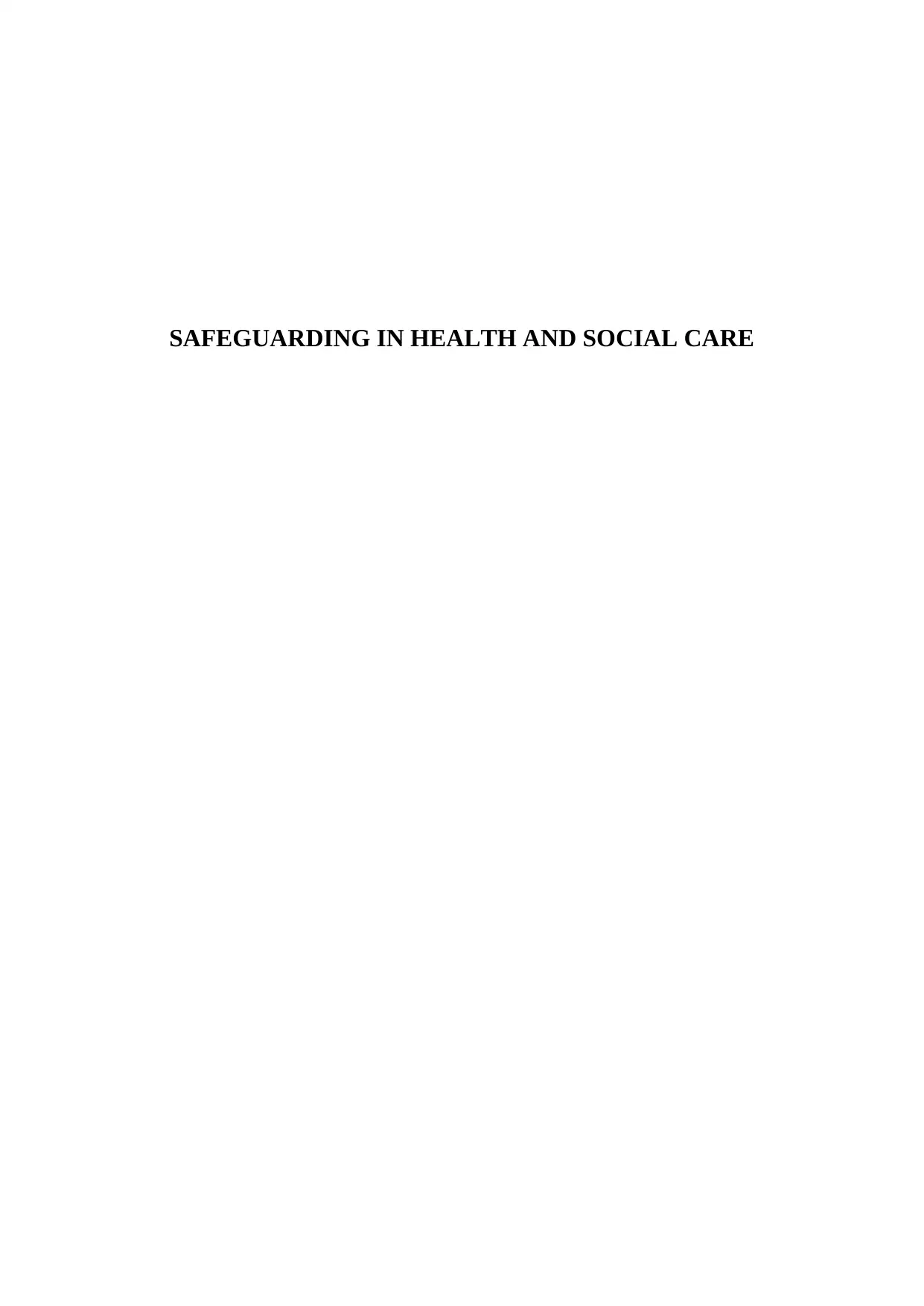
SAFEGUARDING IN HEALTH AND SOCIAL CARE
Paraphrase This Document
Need a fresh take? Get an instant paraphrase of this document with our AI Paraphraser
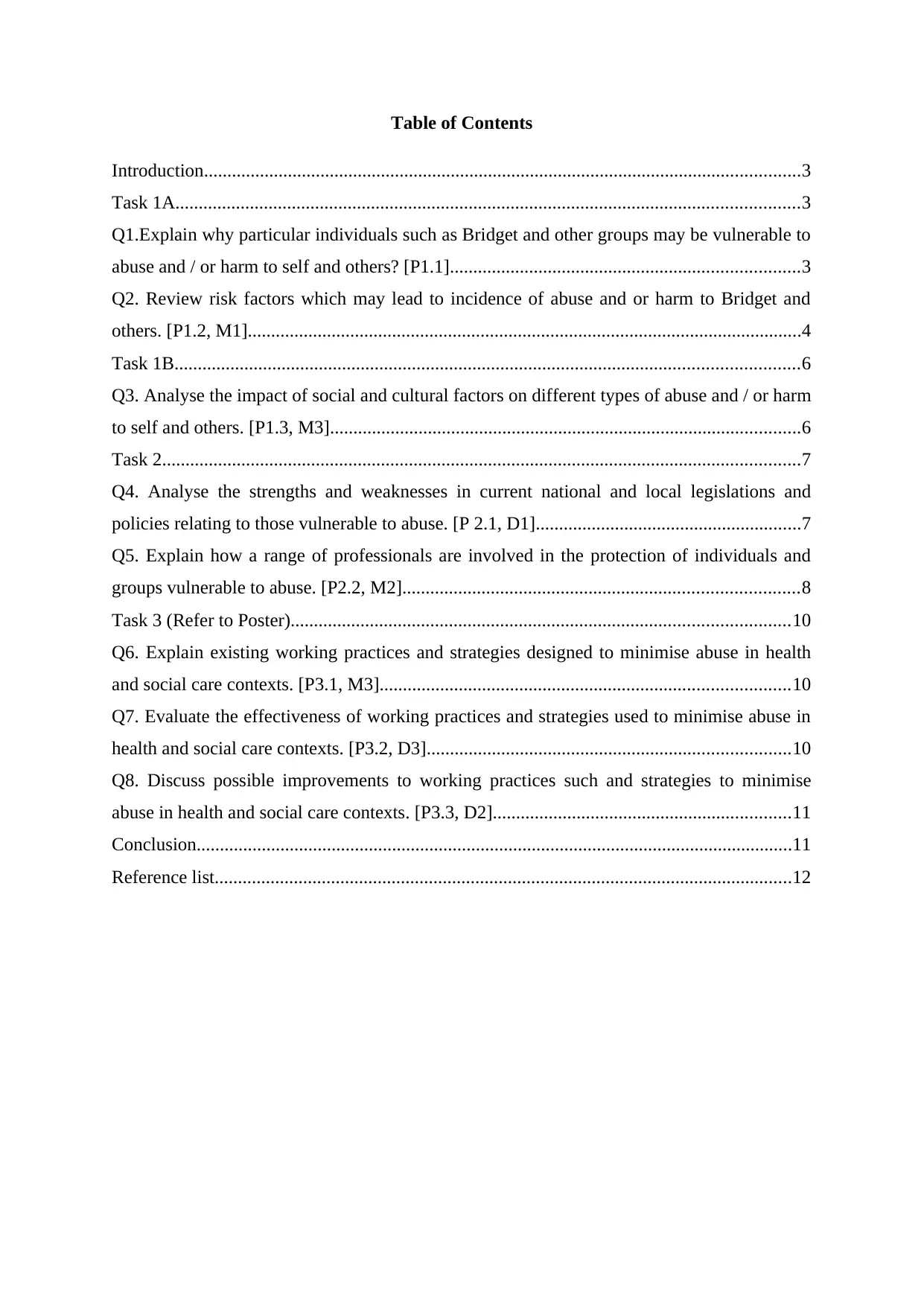
Table of Contents
Introduction................................................................................................................................3
Task 1A......................................................................................................................................3
Q1.Explain why particular individuals such as Bridget and other groups may be vulnerable to
abuse and / or harm to self and others? [P1.1]...........................................................................3
Q2. Review risk factors which may lead to incidence of abuse and or harm to Bridget and
others. [P1.2, M1].......................................................................................................................4
Task 1B......................................................................................................................................6
Q3. Analyse the impact of social and cultural factors on different types of abuse and / or harm
to self and others. [P1.3, M3].....................................................................................................6
Task 2.........................................................................................................................................7
Q4. Analyse the strengths and weaknesses in current national and local legislations and
policies relating to those vulnerable to abuse. [P 2.1, D1].........................................................7
Q5. Explain how a range of professionals are involved in the protection of individuals and
groups vulnerable to abuse. [P2.2, M2].....................................................................................8
Task 3 (Refer to Poster)...........................................................................................................10
Q6. Explain existing working practices and strategies designed to minimise abuse in health
and social care contexts. [P3.1, M3]........................................................................................10
Q7. Evaluate the effectiveness of working practices and strategies used to minimise abuse in
health and social care contexts. [P3.2, D3]..............................................................................10
Q8. Discuss possible improvements to working practices such and strategies to minimise
abuse in health and social care contexts. [P3.3, D2]................................................................11
Conclusion................................................................................................................................11
Reference list............................................................................................................................12
Introduction................................................................................................................................3
Task 1A......................................................................................................................................3
Q1.Explain why particular individuals such as Bridget and other groups may be vulnerable to
abuse and / or harm to self and others? [P1.1]...........................................................................3
Q2. Review risk factors which may lead to incidence of abuse and or harm to Bridget and
others. [P1.2, M1].......................................................................................................................4
Task 1B......................................................................................................................................6
Q3. Analyse the impact of social and cultural factors on different types of abuse and / or harm
to self and others. [P1.3, M3].....................................................................................................6
Task 2.........................................................................................................................................7
Q4. Analyse the strengths and weaknesses in current national and local legislations and
policies relating to those vulnerable to abuse. [P 2.1, D1].........................................................7
Q5. Explain how a range of professionals are involved in the protection of individuals and
groups vulnerable to abuse. [P2.2, M2].....................................................................................8
Task 3 (Refer to Poster)...........................................................................................................10
Q6. Explain existing working practices and strategies designed to minimise abuse in health
and social care contexts. [P3.1, M3]........................................................................................10
Q7. Evaluate the effectiveness of working practices and strategies used to minimise abuse in
health and social care contexts. [P3.2, D3]..............................................................................10
Q8. Discuss possible improvements to working practices such and strategies to minimise
abuse in health and social care contexts. [P3.3, D2]................................................................11
Conclusion................................................................................................................................11
Reference list............................................................................................................................12
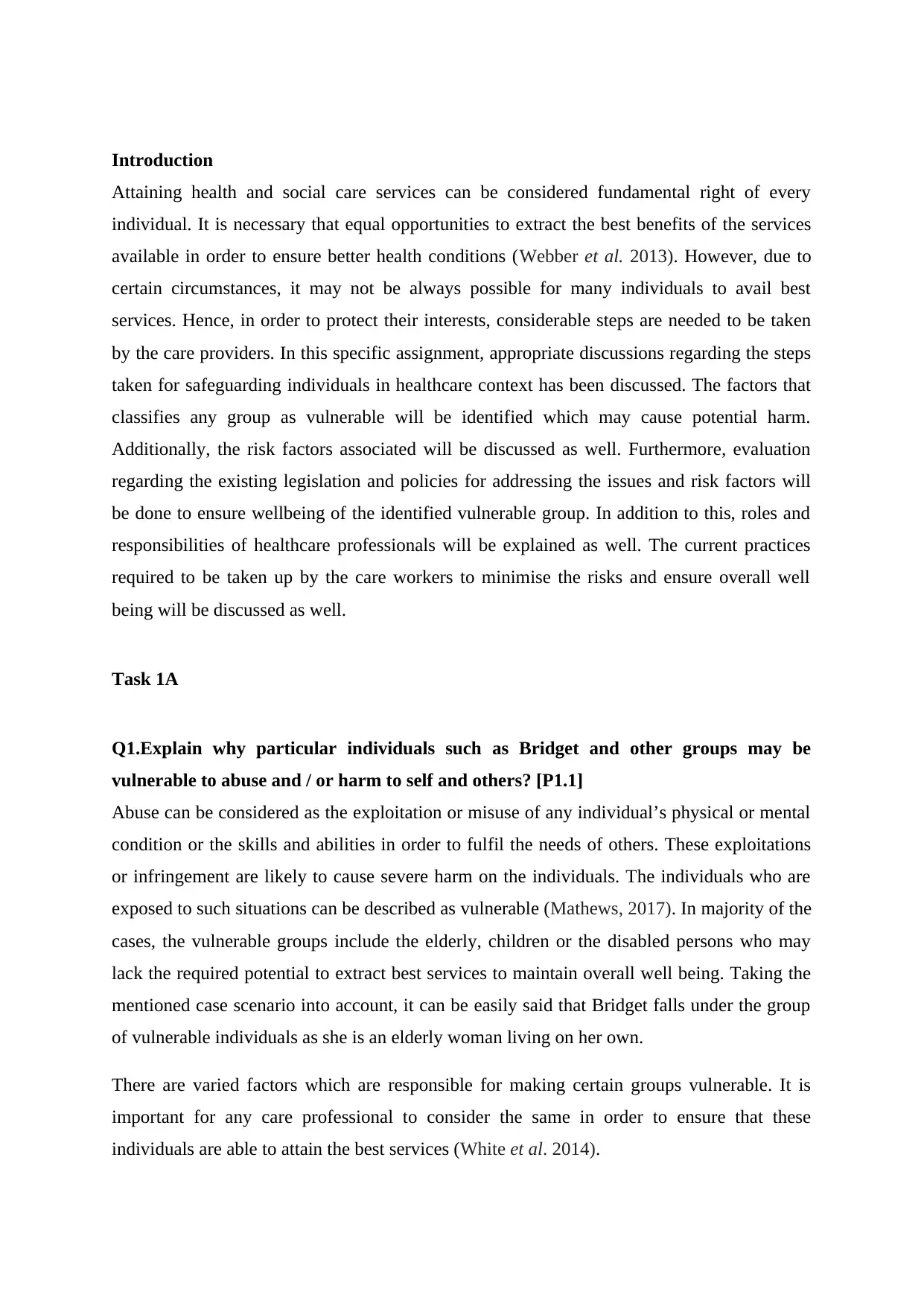
Introduction
Attaining health and social care services can be considered fundamental right of every
individual. It is necessary that equal opportunities to extract the best benefits of the services
available in order to ensure better health conditions (Webber et al. 2013). However, due to
certain circumstances, it may not be always possible for many individuals to avail best
services. Hence, in order to protect their interests, considerable steps are needed to be taken
by the care providers. In this specific assignment, appropriate discussions regarding the steps
taken for safeguarding individuals in healthcare context has been discussed. The factors that
classifies any group as vulnerable will be identified which may cause potential harm.
Additionally, the risk factors associated will be discussed as well. Furthermore, evaluation
regarding the existing legislation and policies for addressing the issues and risk factors will
be done to ensure wellbeing of the identified vulnerable group. In addition to this, roles and
responsibilities of healthcare professionals will be explained as well. The current practices
required to be taken up by the care workers to minimise the risks and ensure overall well
being will be discussed as well.
Task 1A
Q1.Explain why particular individuals such as Bridget and other groups may be
vulnerable to abuse and / or harm to self and others? [P1.1]
Abuse can be considered as the exploitation or misuse of any individual’s physical or mental
condition or the skills and abilities in order to fulfil the needs of others. These exploitations
or infringement are likely to cause severe harm on the individuals. The individuals who are
exposed to such situations can be described as vulnerable (Mathews, 2017). In majority of the
cases, the vulnerable groups include the elderly, children or the disabled persons who may
lack the required potential to extract best services to maintain overall well being. Taking the
mentioned case scenario into account, it can be easily said that Bridget falls under the group
of vulnerable individuals as she is an elderly woman living on her own.
There are varied factors which are responsible for making certain groups vulnerable. It is
important for any care professional to consider the same in order to ensure that these
individuals are able to attain the best services (White et al. 2014).
Attaining health and social care services can be considered fundamental right of every
individual. It is necessary that equal opportunities to extract the best benefits of the services
available in order to ensure better health conditions (Webber et al. 2013). However, due to
certain circumstances, it may not be always possible for many individuals to avail best
services. Hence, in order to protect their interests, considerable steps are needed to be taken
by the care providers. In this specific assignment, appropriate discussions regarding the steps
taken for safeguarding individuals in healthcare context has been discussed. The factors that
classifies any group as vulnerable will be identified which may cause potential harm.
Additionally, the risk factors associated will be discussed as well. Furthermore, evaluation
regarding the existing legislation and policies for addressing the issues and risk factors will
be done to ensure wellbeing of the identified vulnerable group. In addition to this, roles and
responsibilities of healthcare professionals will be explained as well. The current practices
required to be taken up by the care workers to minimise the risks and ensure overall well
being will be discussed as well.
Task 1A
Q1.Explain why particular individuals such as Bridget and other groups may be
vulnerable to abuse and / or harm to self and others? [P1.1]
Abuse can be considered as the exploitation or misuse of any individual’s physical or mental
condition or the skills and abilities in order to fulfil the needs of others. These exploitations
or infringement are likely to cause severe harm on the individuals. The individuals who are
exposed to such situations can be described as vulnerable (Mathews, 2017). In majority of the
cases, the vulnerable groups include the elderly, children or the disabled persons who may
lack the required potential to extract best services to maintain overall well being. Taking the
mentioned case scenario into account, it can be easily said that Bridget falls under the group
of vulnerable individuals as she is an elderly woman living on her own.
There are varied factors which are responsible for making certain groups vulnerable. It is
important for any care professional to consider the same in order to ensure that these
individuals are able to attain the best services (White et al. 2014).
⊘ This is a preview!⊘
Do you want full access?
Subscribe today to unlock all pages.

Trusted by 1+ million students worldwide
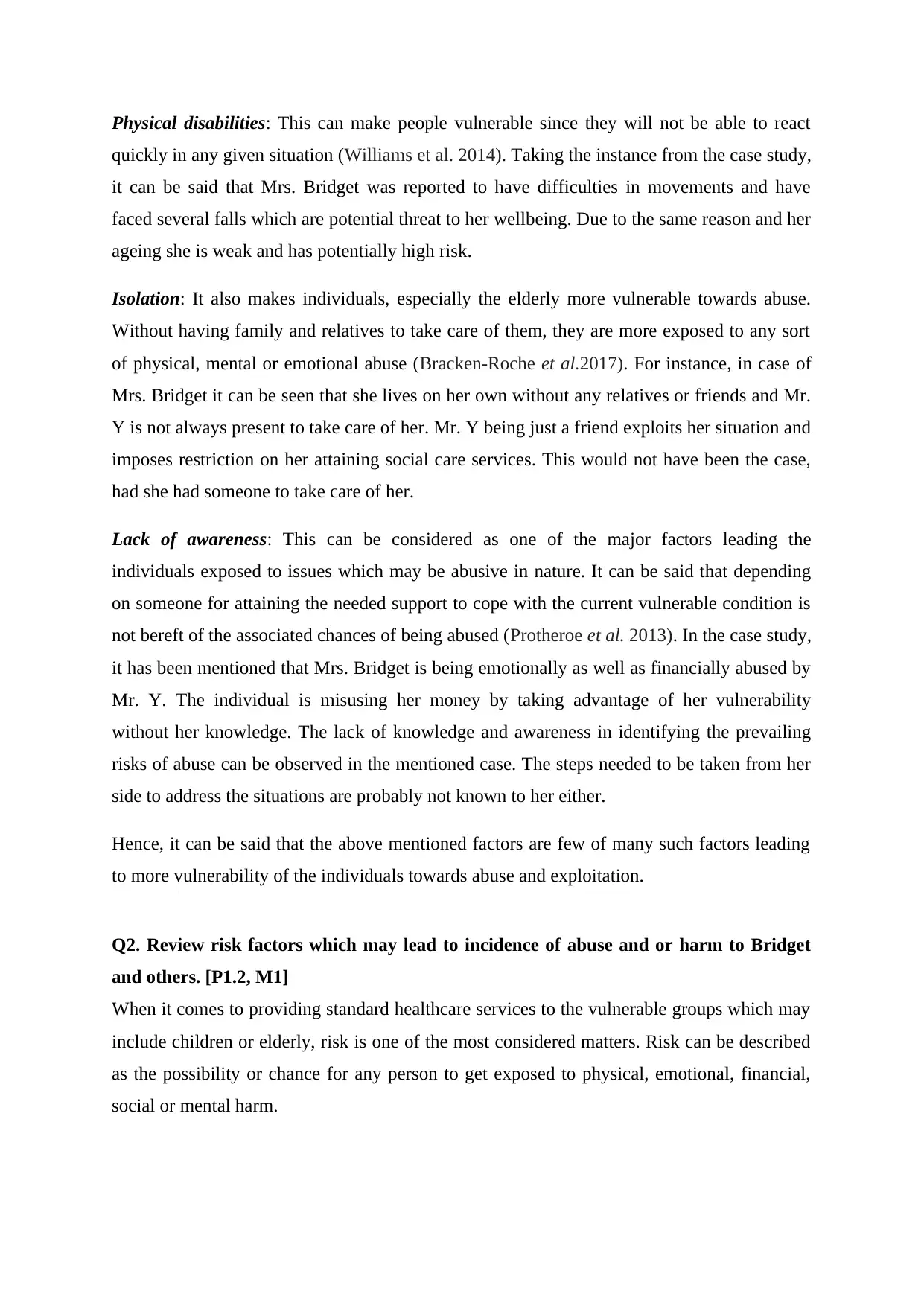
Physical disabilities: This can make people vulnerable since they will not be able to react
quickly in any given situation (Williams et al. 2014). Taking the instance from the case study,
it can be said that Mrs. Bridget was reported to have difficulties in movements and have
faced several falls which are potential threat to her wellbeing. Due to the same reason and her
ageing she is weak and has potentially high risk.
Isolation: It also makes individuals, especially the elderly more vulnerable towards abuse.
Without having family and relatives to take care of them, they are more exposed to any sort
of physical, mental or emotional abuse (Bracken-Roche et al.2017). For instance, in case of
Mrs. Bridget it can be seen that she lives on her own without any relatives or friends and Mr.
Y is not always present to take care of her. Mr. Y being just a friend exploits her situation and
imposes restriction on her attaining social care services. This would not have been the case,
had she had someone to take care of her.
Lack of awareness: This can be considered as one of the major factors leading the
individuals exposed to issues which may be abusive in nature. It can be said that depending
on someone for attaining the needed support to cope with the current vulnerable condition is
not bereft of the associated chances of being abused (Protheroe et al. 2013). In the case study,
it has been mentioned that Mrs. Bridget is being emotionally as well as financially abused by
Mr. Y. The individual is misusing her money by taking advantage of her vulnerability
without her knowledge. The lack of knowledge and awareness in identifying the prevailing
risks of abuse can be observed in the mentioned case. The steps needed to be taken from her
side to address the situations are probably not known to her either.
Hence, it can be said that the above mentioned factors are few of many such factors leading
to more vulnerability of the individuals towards abuse and exploitation.
Q2. Review risk factors which may lead to incidence of abuse and or harm to Bridget
and others. [P1.2, M1]
When it comes to providing standard healthcare services to the vulnerable groups which may
include children or elderly, risk is one of the most considered matters. Risk can be described
as the possibility or chance for any person to get exposed to physical, emotional, financial,
social or mental harm.
quickly in any given situation (Williams et al. 2014). Taking the instance from the case study,
it can be said that Mrs. Bridget was reported to have difficulties in movements and have
faced several falls which are potential threat to her wellbeing. Due to the same reason and her
ageing she is weak and has potentially high risk.
Isolation: It also makes individuals, especially the elderly more vulnerable towards abuse.
Without having family and relatives to take care of them, they are more exposed to any sort
of physical, mental or emotional abuse (Bracken-Roche et al.2017). For instance, in case of
Mrs. Bridget it can be seen that she lives on her own without any relatives or friends and Mr.
Y is not always present to take care of her. Mr. Y being just a friend exploits her situation and
imposes restriction on her attaining social care services. This would not have been the case,
had she had someone to take care of her.
Lack of awareness: This can be considered as one of the major factors leading the
individuals exposed to issues which may be abusive in nature. It can be said that depending
on someone for attaining the needed support to cope with the current vulnerable condition is
not bereft of the associated chances of being abused (Protheroe et al. 2013). In the case study,
it has been mentioned that Mrs. Bridget is being emotionally as well as financially abused by
Mr. Y. The individual is misusing her money by taking advantage of her vulnerability
without her knowledge. The lack of knowledge and awareness in identifying the prevailing
risks of abuse can be observed in the mentioned case. The steps needed to be taken from her
side to address the situations are probably not known to her either.
Hence, it can be said that the above mentioned factors are few of many such factors leading
to more vulnerability of the individuals towards abuse and exploitation.
Q2. Review risk factors which may lead to incidence of abuse and or harm to Bridget
and others. [P1.2, M1]
When it comes to providing standard healthcare services to the vulnerable groups which may
include children or elderly, risk is one of the most considered matters. Risk can be described
as the possibility or chance for any person to get exposed to physical, emotional, financial,
social or mental harm.
Paraphrase This Document
Need a fresh take? Get an instant paraphrase of this document with our AI Paraphraser

The emergence of risks by being psychologically unstable is can have impact on the health
condition of any individual. These kinds of issues are developed in persons due to conditions
like loneliness and rejection (Hirsch et al. 2017). It can be considered that in the mentioned
case study, Mrs. Bridget has high chances of developing issues as such. For instance, it is
evident that she is suffering from loneliness and isolation. She does not have any family
members to take care of her (White et al. 2015). Her only relative is her surviving brother
who lives in some other place. Hence, the dependency on her guest Mr. Y is more who tends
to abuse her emotionally and financially. He is not always present to look after her as well.
These types of situations can also lead to further psychological disorders. Conditions like
anxiety and migration can develop. The chances of self harm can also develop.
Social risks are the conditions where the individuals may be surrounded with potentially
hazardous company and lack of social support. The individuals who may have aggressive or
certain negative approaches can cause further harm to the existing vulnerable condition of the
individual (Yon et al. 2017). It can be observed in the case of the mentioned case study to
make sure that Mrs. Bridget is dependent on Mr. Y in many ways. She shares a complex
relationship with him. However, even though Mr. Y appears to be concerned for her, it can be
seen that he is not always available to ensure her well being. In addition to this, she is
restricted from attaining quality services. The major purpose is detected to be the concern
relating to the finances of Mrs. Bridget that he happens to be beneficiary. Hence, it can be
said that the feeling of isolation during his absence and is restriction for attaining better
health services are some of the social harms that are existent in the mentioned case study.
Furthermore, taking the care providers observation into account it can also be claimed that
Mr. Y has been treating her in a manner that would be further harmful for her health.
Additionally, the chances of financial harm can be also observed. Mr. Y has been taking care
of her finances as well as her. It is suspected that he has been drawing huge amount of money
from her savings. Her missing jewellery and other items were found in his room.
Additionally, the chances of physical risks having potential to harm vulnerable groups should
not be ignored either. Due to lack of care and attention, the individuals can suffer situations
like accidents that can cause physical harm. In the mentioned case study, it can be seen that
Mrs. Bridget has been physically weak and having struggles with her movements. She is
likely to face accidents if proper support is not provided (Astrup et al. 2017). Additionally,
according to the carers’ observations it has also been noted that the attitude of Mr. Y towards
her can also cause further physical harm. Be it not being physically present to take care of her
condition of any individual. These kinds of issues are developed in persons due to conditions
like loneliness and rejection (Hirsch et al. 2017). It can be considered that in the mentioned
case study, Mrs. Bridget has high chances of developing issues as such. For instance, it is
evident that she is suffering from loneliness and isolation. She does not have any family
members to take care of her (White et al. 2015). Her only relative is her surviving brother
who lives in some other place. Hence, the dependency on her guest Mr. Y is more who tends
to abuse her emotionally and financially. He is not always present to look after her as well.
These types of situations can also lead to further psychological disorders. Conditions like
anxiety and migration can develop. The chances of self harm can also develop.
Social risks are the conditions where the individuals may be surrounded with potentially
hazardous company and lack of social support. The individuals who may have aggressive or
certain negative approaches can cause further harm to the existing vulnerable condition of the
individual (Yon et al. 2017). It can be observed in the case of the mentioned case study to
make sure that Mrs. Bridget is dependent on Mr. Y in many ways. She shares a complex
relationship with him. However, even though Mr. Y appears to be concerned for her, it can be
seen that he is not always available to ensure her well being. In addition to this, she is
restricted from attaining quality services. The major purpose is detected to be the concern
relating to the finances of Mrs. Bridget that he happens to be beneficiary. Hence, it can be
said that the feeling of isolation during his absence and is restriction for attaining better
health services are some of the social harms that are existent in the mentioned case study.
Furthermore, taking the care providers observation into account it can also be claimed that
Mr. Y has been treating her in a manner that would be further harmful for her health.
Additionally, the chances of financial harm can be also observed. Mr. Y has been taking care
of her finances as well as her. It is suspected that he has been drawing huge amount of money
from her savings. Her missing jewellery and other items were found in his room.
Additionally, the chances of physical risks having potential to harm vulnerable groups should
not be ignored either. Due to lack of care and attention, the individuals can suffer situations
like accidents that can cause physical harm. In the mentioned case study, it can be seen that
Mrs. Bridget has been physically weak and having struggles with her movements. She is
likely to face accidents if proper support is not provided (Astrup et al. 2017). Additionally,
according to the carers’ observations it has also been noted that the attitude of Mr. Y towards
her can also cause further physical harm. Be it not being physically present to take care of her
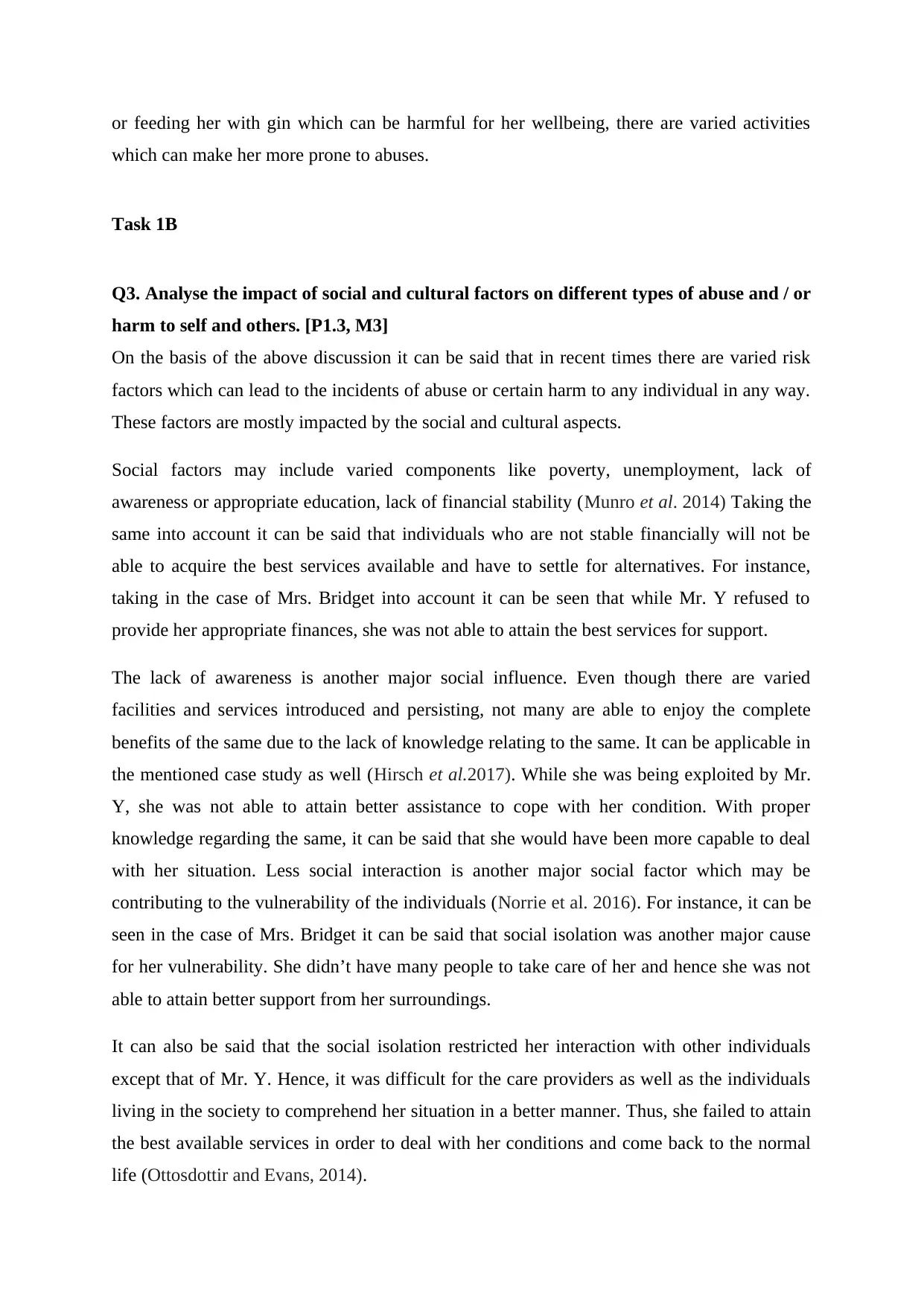
or feeding her with gin which can be harmful for her wellbeing, there are varied activities
which can make her more prone to abuses.
Task 1B
Q3. Analyse the impact of social and cultural factors on different types of abuse and / or
harm to self and others. [P1.3, M3]
On the basis of the above discussion it can be said that in recent times there are varied risk
factors which can lead to the incidents of abuse or certain harm to any individual in any way.
These factors are mostly impacted by the social and cultural aspects.
Social factors may include varied components like poverty, unemployment, lack of
awareness or appropriate education, lack of financial stability (Munro et al. 2014) Taking the
same into account it can be said that individuals who are not stable financially will not be
able to acquire the best services available and have to settle for alternatives. For instance,
taking in the case of Mrs. Bridget into account it can be seen that while Mr. Y refused to
provide her appropriate finances, she was not able to attain the best services for support.
The lack of awareness is another major social influence. Even though there are varied
facilities and services introduced and persisting, not many are able to enjoy the complete
benefits of the same due to the lack of knowledge relating to the same. It can be applicable in
the mentioned case study as well (Hirsch et al.2017). While she was being exploited by Mr.
Y, she was not able to attain better assistance to cope with her condition. With proper
knowledge regarding the same, it can be said that she would have been more capable to deal
with her situation. Less social interaction is another major social factor which may be
contributing to the vulnerability of the individuals (Norrie et al. 2016). For instance, it can be
seen in the case of Mrs. Bridget it can be said that social isolation was another major cause
for her vulnerability. She didn’t have many people to take care of her and hence she was not
able to attain better support from her surroundings.
It can also be said that the social isolation restricted her interaction with other individuals
except that of Mr. Y. Hence, it was difficult for the care providers as well as the individuals
living in the society to comprehend her situation in a better manner. Thus, she failed to attain
the best available services in order to deal with her conditions and come back to the normal
life (Ottosdottir and Evans, 2014).
which can make her more prone to abuses.
Task 1B
Q3. Analyse the impact of social and cultural factors on different types of abuse and / or
harm to self and others. [P1.3, M3]
On the basis of the above discussion it can be said that in recent times there are varied risk
factors which can lead to the incidents of abuse or certain harm to any individual in any way.
These factors are mostly impacted by the social and cultural aspects.
Social factors may include varied components like poverty, unemployment, lack of
awareness or appropriate education, lack of financial stability (Munro et al. 2014) Taking the
same into account it can be said that individuals who are not stable financially will not be
able to acquire the best services available and have to settle for alternatives. For instance,
taking in the case of Mrs. Bridget into account it can be seen that while Mr. Y refused to
provide her appropriate finances, she was not able to attain the best services for support.
The lack of awareness is another major social influence. Even though there are varied
facilities and services introduced and persisting, not many are able to enjoy the complete
benefits of the same due to the lack of knowledge relating to the same. It can be applicable in
the mentioned case study as well (Hirsch et al.2017). While she was being exploited by Mr.
Y, she was not able to attain better assistance to cope with her condition. With proper
knowledge regarding the same, it can be said that she would have been more capable to deal
with her situation. Less social interaction is another major social factor which may be
contributing to the vulnerability of the individuals (Norrie et al. 2016). For instance, it can be
seen in the case of Mrs. Bridget it can be said that social isolation was another major cause
for her vulnerability. She didn’t have many people to take care of her and hence she was not
able to attain better support from her surroundings.
It can also be said that the social isolation restricted her interaction with other individuals
except that of Mr. Y. Hence, it was difficult for the care providers as well as the individuals
living in the society to comprehend her situation in a better manner. Thus, she failed to attain
the best available services in order to deal with her conditions and come back to the normal
life (Ottosdottir and Evans, 2014).
⊘ This is a preview!⊘
Do you want full access?
Subscribe today to unlock all pages.

Trusted by 1+ million students worldwide
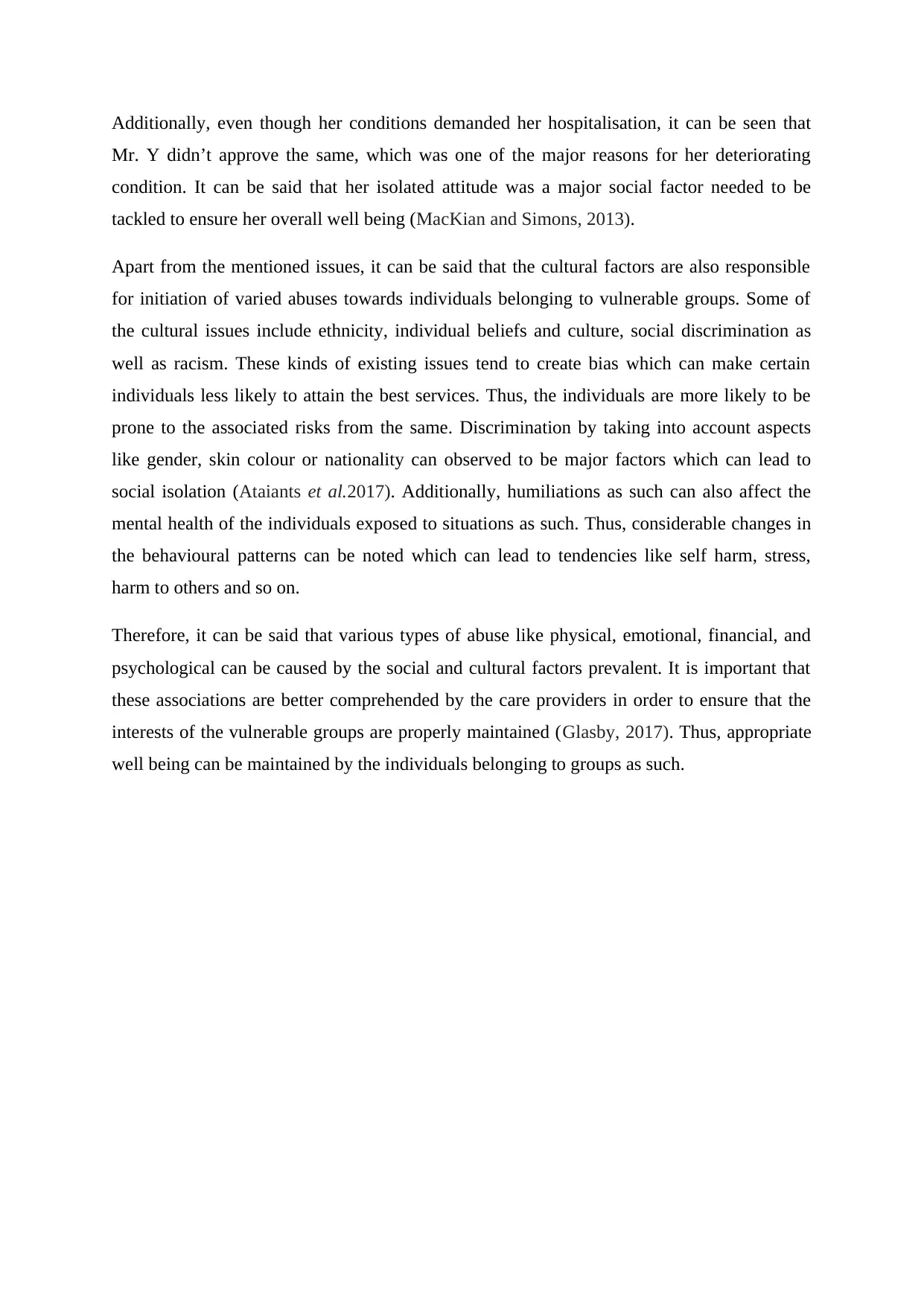
Additionally, even though her conditions demanded her hospitalisation, it can be seen that
Mr. Y didn’t approve the same, which was one of the major reasons for her deteriorating
condition. It can be said that her isolated attitude was a major social factor needed to be
tackled to ensure her overall well being (MacKian and Simons, 2013).
Apart from the mentioned issues, it can be said that the cultural factors are also responsible
for initiation of varied abuses towards individuals belonging to vulnerable groups. Some of
the cultural issues include ethnicity, individual beliefs and culture, social discrimination as
well as racism. These kinds of existing issues tend to create bias which can make certain
individuals less likely to attain the best services. Thus, the individuals are more likely to be
prone to the associated risks from the same. Discrimination by taking into account aspects
like gender, skin colour or nationality can observed to be major factors which can lead to
social isolation (Ataiants et al.2017). Additionally, humiliations as such can also affect the
mental health of the individuals exposed to situations as such. Thus, considerable changes in
the behavioural patterns can be noted which can lead to tendencies like self harm, stress,
harm to others and so on.
Therefore, it can be said that various types of abuse like physical, emotional, financial, and
psychological can be caused by the social and cultural factors prevalent. It is important that
these associations are better comprehended by the care providers in order to ensure that the
interests of the vulnerable groups are properly maintained (Glasby, 2017). Thus, appropriate
well being can be maintained by the individuals belonging to groups as such.
Mr. Y didn’t approve the same, which was one of the major reasons for her deteriorating
condition. It can be said that her isolated attitude was a major social factor needed to be
tackled to ensure her overall well being (MacKian and Simons, 2013).
Apart from the mentioned issues, it can be said that the cultural factors are also responsible
for initiation of varied abuses towards individuals belonging to vulnerable groups. Some of
the cultural issues include ethnicity, individual beliefs and culture, social discrimination as
well as racism. These kinds of existing issues tend to create bias which can make certain
individuals less likely to attain the best services. Thus, the individuals are more likely to be
prone to the associated risks from the same. Discrimination by taking into account aspects
like gender, skin colour or nationality can observed to be major factors which can lead to
social isolation (Ataiants et al.2017). Additionally, humiliations as such can also affect the
mental health of the individuals exposed to situations as such. Thus, considerable changes in
the behavioural patterns can be noted which can lead to tendencies like self harm, stress,
harm to others and so on.
Therefore, it can be said that various types of abuse like physical, emotional, financial, and
psychological can be caused by the social and cultural factors prevalent. It is important that
these associations are better comprehended by the care providers in order to ensure that the
interests of the vulnerable groups are properly maintained (Glasby, 2017). Thus, appropriate
well being can be maintained by the individuals belonging to groups as such.
Paraphrase This Document
Need a fresh take? Get an instant paraphrase of this document with our AI Paraphraser
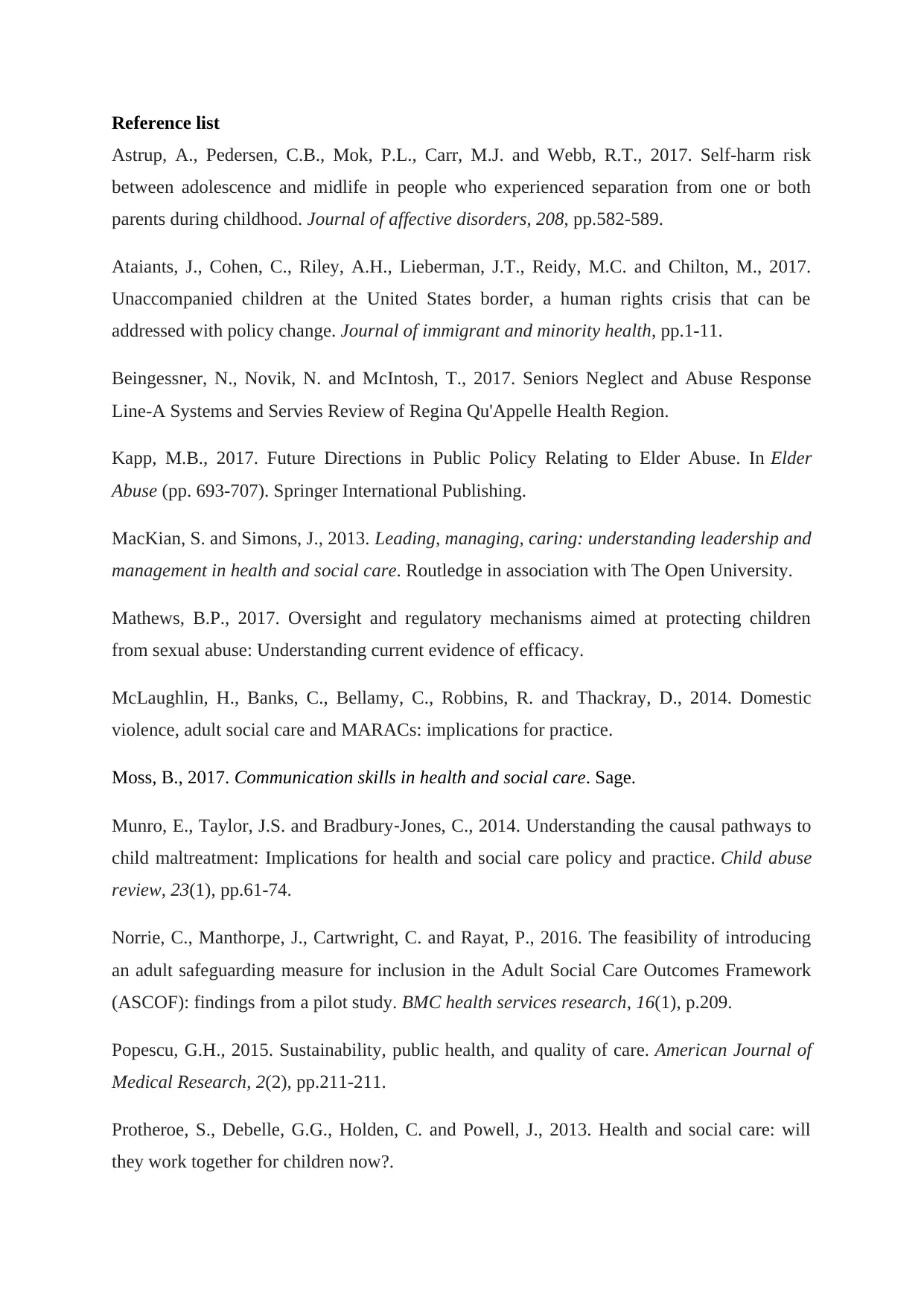
Reference list
Astrup, A., Pedersen, C.B., Mok, P.L., Carr, M.J. and Webb, R.T., 2017. Self-harm risk
between adolescence and midlife in people who experienced separation from one or both
parents during childhood. Journal of affective disorders, 208, pp.582-589.
Ataiants, J., Cohen, C., Riley, A.H., Lieberman, J.T., Reidy, M.C. and Chilton, M., 2017.
Unaccompanied children at the United States border, a human rights crisis that can be
addressed with policy change. Journal of immigrant and minority health, pp.1-11.
Beingessner, N., Novik, N. and McIntosh, T., 2017. Seniors Neglect and Abuse Response
Line-A Systems and Servies Review of Regina Qu'Appelle Health Region.
Kapp, M.B., 2017. Future Directions in Public Policy Relating to Elder Abuse. In Elder
Abuse (pp. 693-707). Springer International Publishing.
MacKian, S. and Simons, J., 2013. Leading, managing, caring: understanding leadership and
management in health and social care. Routledge in association with The Open University.
Mathews, B.P., 2017. Oversight and regulatory mechanisms aimed at protecting children
from sexual abuse: Understanding current evidence of efficacy.
McLaughlin, H., Banks, C., Bellamy, C., Robbins, R. and Thackray, D., 2014. Domestic
violence, adult social care and MARACs: implications for practice.
Moss, B., 2017. Communication skills in health and social care. Sage.
Munro, E., Taylor, J.S. and Bradbury‐Jones, C., 2014. Understanding the causal pathways to
child maltreatment: Implications for health and social care policy and practice. Child abuse
review, 23(1), pp.61-74.
Norrie, C., Manthorpe, J., Cartwright, C. and Rayat, P., 2016. The feasibility of introducing
an adult safeguarding measure for inclusion in the Adult Social Care Outcomes Framework
(ASCOF): findings from a pilot study. BMC health services research, 16(1), p.209.
Popescu, G.H., 2015. Sustainability, public health, and quality of care. American Journal of
Medical Research, 2(2), pp.211-211.
Protheroe, S., Debelle, G.G., Holden, C. and Powell, J., 2013. Health and social care: will
they work together for children now?.
Astrup, A., Pedersen, C.B., Mok, P.L., Carr, M.J. and Webb, R.T., 2017. Self-harm risk
between adolescence and midlife in people who experienced separation from one or both
parents during childhood. Journal of affective disorders, 208, pp.582-589.
Ataiants, J., Cohen, C., Riley, A.H., Lieberman, J.T., Reidy, M.C. and Chilton, M., 2017.
Unaccompanied children at the United States border, a human rights crisis that can be
addressed with policy change. Journal of immigrant and minority health, pp.1-11.
Beingessner, N., Novik, N. and McIntosh, T., 2017. Seniors Neglect and Abuse Response
Line-A Systems and Servies Review of Regina Qu'Appelle Health Region.
Kapp, M.B., 2017. Future Directions in Public Policy Relating to Elder Abuse. In Elder
Abuse (pp. 693-707). Springer International Publishing.
MacKian, S. and Simons, J., 2013. Leading, managing, caring: understanding leadership and
management in health and social care. Routledge in association with The Open University.
Mathews, B.P., 2017. Oversight and regulatory mechanisms aimed at protecting children
from sexual abuse: Understanding current evidence of efficacy.
McLaughlin, H., Banks, C., Bellamy, C., Robbins, R. and Thackray, D., 2014. Domestic
violence, adult social care and MARACs: implications for practice.
Moss, B., 2017. Communication skills in health and social care. Sage.
Munro, E., Taylor, J.S. and Bradbury‐Jones, C., 2014. Understanding the causal pathways to
child maltreatment: Implications for health and social care policy and practice. Child abuse
review, 23(1), pp.61-74.
Norrie, C., Manthorpe, J., Cartwright, C. and Rayat, P., 2016. The feasibility of introducing
an adult safeguarding measure for inclusion in the Adult Social Care Outcomes Framework
(ASCOF): findings from a pilot study. BMC health services research, 16(1), p.209.
Popescu, G.H., 2015. Sustainability, public health, and quality of care. American Journal of
Medical Research, 2(2), pp.211-211.
Protheroe, S., Debelle, G.G., Holden, C. and Powell, J., 2013. Health and social care: will
they work together for children now?.
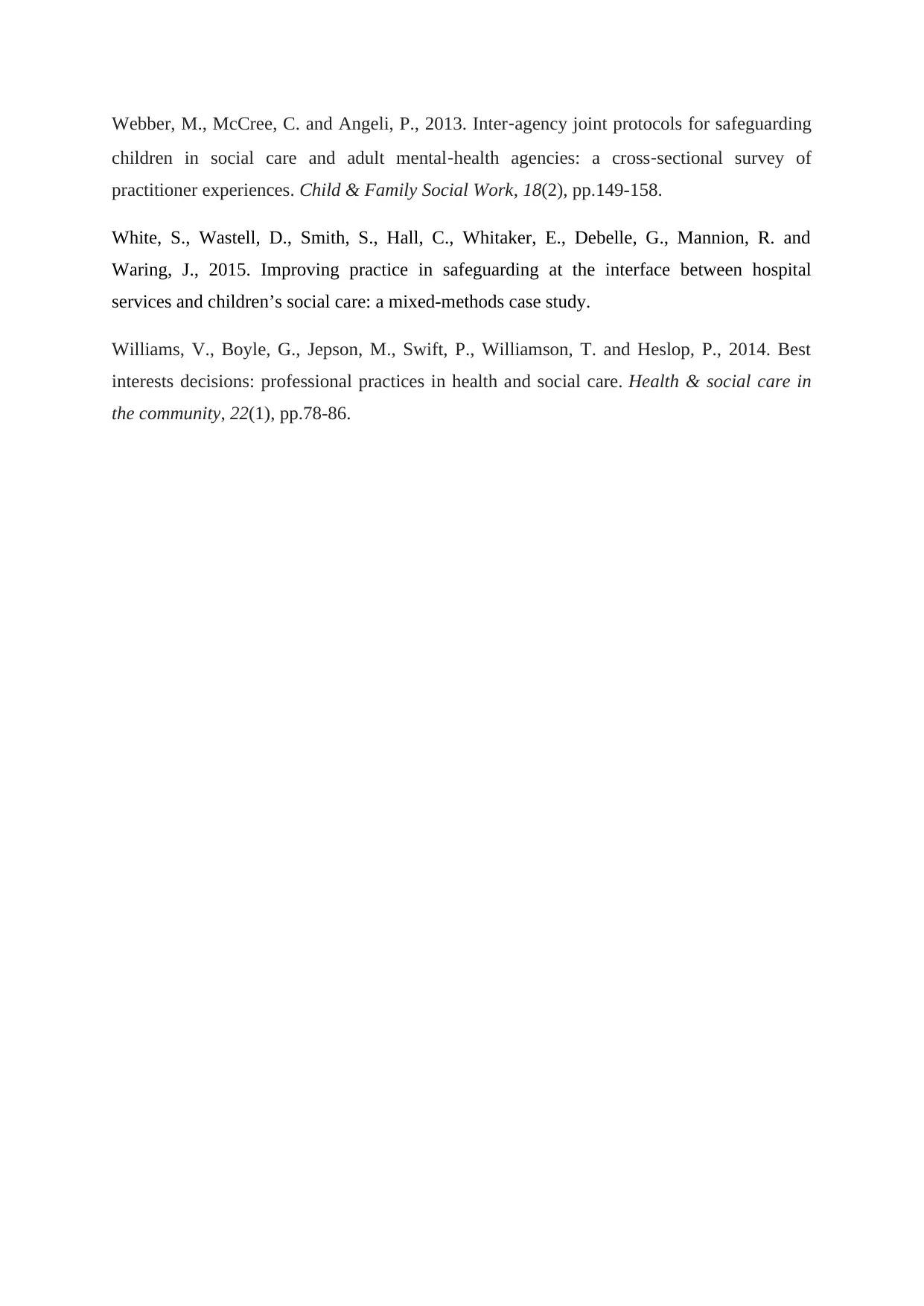
Webber, M., McCree, C. and Angeli, P., 2013. Inter‐agency joint protocols for safeguarding
children in social care and adult mental‐health agencies: a cross‐sectional survey of
practitioner experiences. Child & Family Social Work, 18(2), pp.149-158.
White, S., Wastell, D., Smith, S., Hall, C., Whitaker, E., Debelle, G., Mannion, R. and
Waring, J., 2015. Improving practice in safeguarding at the interface between hospital
services and children’s social care: a mixed-methods case study.
Williams, V., Boyle, G., Jepson, M., Swift, P., Williamson, T. and Heslop, P., 2014. Best
interests decisions: professional practices in health and social care. Health & social care in
the community, 22(1), pp.78-86.
children in social care and adult mental‐health agencies: a cross‐sectional survey of
practitioner experiences. Child & Family Social Work, 18(2), pp.149-158.
White, S., Wastell, D., Smith, S., Hall, C., Whitaker, E., Debelle, G., Mannion, R. and
Waring, J., 2015. Improving practice in safeguarding at the interface between hospital
services and children’s social care: a mixed-methods case study.
Williams, V., Boyle, G., Jepson, M., Swift, P., Williamson, T. and Heslop, P., 2014. Best
interests decisions: professional practices in health and social care. Health & social care in
the community, 22(1), pp.78-86.
⊘ This is a preview!⊘
Do you want full access?
Subscribe today to unlock all pages.

Trusted by 1+ million students worldwide
1 out of 9
Related Documents
Your All-in-One AI-Powered Toolkit for Academic Success.
+13062052269
info@desklib.com
Available 24*7 on WhatsApp / Email
![[object Object]](/_next/static/media/star-bottom.7253800d.svg)
Unlock your academic potential
Copyright © 2020–2025 A2Z Services. All Rights Reserved. Developed and managed by ZUCOL.





